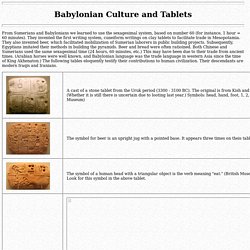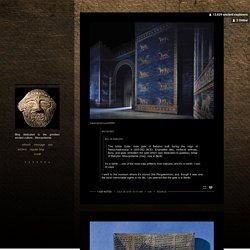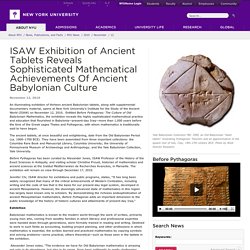

Ziggurats - Explore. Parcours : La fonction royale - Mésopotamie. Dès l’apparition des cités-Etats à la fin du IVe millénaire, jusqu’aux empires assyrien et babylonien du Ier millénaire avant JC, le pouvoir en Mésopotamie a toujours été de nature monarchique.

Se présentant comme l’élu des dieux dont il affirme tenir sa légitimité, le souverain est le garant de la sécurité et de la prospérité de son peuple. À la tête d’une administration puissante, il se fait édifier des palais au luxe incomparable, incarnations du prestige attaché à la fonction royale. C’est avec l’émergence des villes, il y a plus de 5000 ans, et l’organisation de la société en cités-Etats, qu’apparaît en Mésopotamie l’institution royale. Très vite elle s’affirme comme d'origine divine et va se trouver investie d'un caractère sacré qui fonde sa légitimité.
Le souverain est le représentant des dieux sur terre, choisi par eux pour assurer, par sa bonne gouvernance, la prospérité à son peuple. Astronomer story. Collection search: You searched for mesopotamia moon. Registration numbers The most common type of Museum number begins with the year of acquisition.

The database standardises these numbers in the form, for example: 1887,0708.2427 (year: comma: block of four numbers - usually representing a month and day: full-stop and final number). The final number can be of any length and may be followed by another full-stop and a sub-number. In some cases the same number is shared by two or more objects across departments. In some of these cases a prefix has been added before a number (e.g. If the number you are entering has come from an old catalogue it could appear in the form 1887-7-8-2427. In the case of some two-dimensional works from Asia and the Middle East a full stop may need to be inserted into the final number. The second most common type of Museum number takes the form of one or two letters followed by two numbers. BM or 'Big' numbers Other numbering systems. At The British Museum Images - Search Results.
Babylonian Tablets. Sumerians exported beer to faraway countries, even Egypt.

They were the first beer drinkers. They knew how to make beer and they had raw materials. Soon there were surplus of beers and that was the reason for their beer exports. Even in modern times, the Communist bloc countries exported surpluses to other members and avoided trading with free market economies. This Babylonian clay tablet is the first map of the world. Biographie d'Assurbanipal. Deuxième fils d'Asarhaddar, Assurbanipal est choisi par son père pour lui succéder à la tête de l'Empire, tandis que son frère aîné est placé sur le trône de Babylone récemment reconstruite.

Sous son règne, l'Assyrie (située dans l'Irak actuel) devait connaître une ascension fulgurante, étendant ses frontières jusqu'à la Basse-Égypte et dans toute la vallée du « croissant fertile ». Cependant, malgré des campagnes éclatantes, Assurbanipal s'intéresse moins à la guerre qu'aux lettres. Astral sciences [CDLI Wiki] History of Mesopotamia [CDLI Wiki] [BibMAS] Bibliography of Mesopotamian Astral Science. ALL MESOPOTAMIA sur Pinterest. CDLI - Cuneiform Digital Library Initiative. Bibliography of Babylonian Astronomy & Astrology. Astronomer story. Legacy of Tiamat. Swampbarrow40000: alscientist: lion-of-babylon: The Ishtar Gate, main gate of Babylon built during the reign of Nebuchadnezzar II (605-562 BCE).

Enamelled tiles, mythical animals, lions, and gods embellish the gate which was dedicated to goddess Ishtar of Babylon, Mesopotamia (Iraq). now in Berlin it’s in berlin….one of the most iraqi artifacts from babylon, and it’s in berlin. I went to the museum where it’s stored (the Pergaemmon) and, though it was one the most memorable sights in my life, I am peeved that the gate is in Berlin. massarrah: Ancient Legal Textbook from MesopotamiaIf a woman hates her husband and has said to him, “You are not my husband”, they will throw her in the river.Written in cuneiform, this clay tablet records a series of legal terms, phrases, formulae, and some precepts, translated from Sumerian into Akkadian.
A Culture of Mathematics - Slide Show. Thirteen cuneiform clay tablets of ancient Mesopotamia, dating from 1900 to 1700 B.C., are on display until Dec. 17 at the Institute for the Study of the Ancient World, part of New York University.

Many are exercises of students learning to be scribes, who were mastering mathematics based on texts in Sumerian, a language that even at the time was long since dead. The items are drawn from archaeological collections of Columbia, Yale and the University of Pennsylvania and include two celebrated tablets, known as YBC 7289 and Plimpton 322, that have played central roles in the reconstruction of Babylonian math.
Science > Image > Universität Würzburg: detail. Clay tablet with cuneiform writing: 3D scan of a deed of gift for land bearing the seal of King Muwattalli I (15th century BC).

The fragment is approx. 10 centimetres long and originates from Anatolia. Downloads: Cuneiform. Zur Navigation - Zum Inhalt Sie befinden sich hier Inhalt CA_Demo_Visualization.mp4A demo clip that shows some of the visualization features of CuneiformAnalyserCA_Demo_Segmentation.mp4A demo clip that shows some of the wedge segmentation features of CuneiformAnalyserCA_Demo_Joining.mp4A demo clip that shows some of the fragment joining features of CuneiformAnalyser terminology.pdfMulti language table containing terminological definitions for metrological wedge components.

ISAW Exhibition of Ancient Tablets Reveals Sophisticated Mathematical Achievements Of Ancient Babylonian Culture. An illuminating exhibition of thirteen ancient Babylonian tablets, along with supplemental documentary material, opens at New York University’s Institute for the Study of the Ancient World (ISAW) on November 12, 2010.

Entitled Before Pythagoras: The Culture of Old Babylonian Mathematics, the exhibition reveals the highly sophisticated mathematical practice and education that flourished in Babylonia—present-day Iraq—more than 1,000 years before the time of the Greek sages Thales and Pythagoras, with whom mathematics is traditionally said to have begun. The ancient tablets, at once beautiful and enlightening, date from the Old Babylonian Period (ca. 1900–1700 BCE). They have been assembled from three important collections: the Columbia Rare Book and Manuscript Library, Columbia University; the University of Pennsylvania Museum of Archaeology and Anthropology; and the Yale Babylonian Collection, Yale University. Exhibition Institute for the Study of the Ancient World.